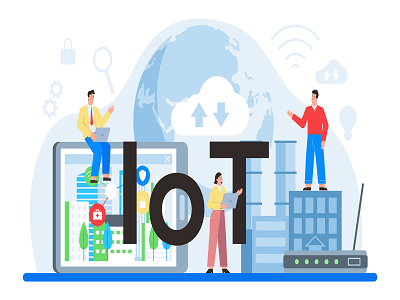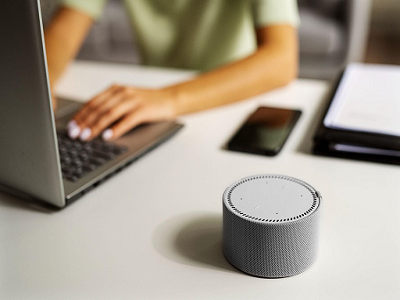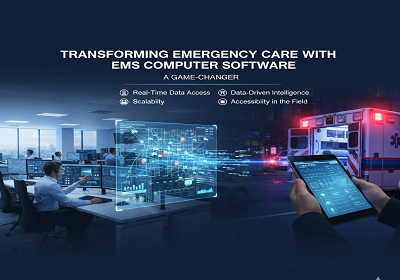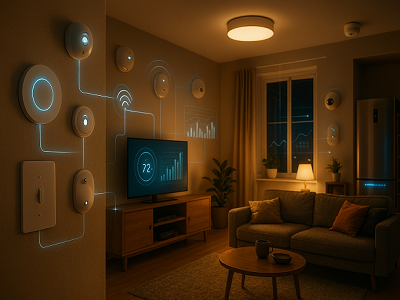
Internet of Things market growth is estimated to be US$ 3,967.99 billion by 2030 from US$ 611.00 billion in 2023 & is estimated to register a CAGR of 30.6% from 2023 to 2030 Internet of Things (IoT) refers to the network of billions of devices interconnected. These all can collect and share data. Computer chips and wireless networks make it possible. Everything from a pen to an airplane could be part of IoT services. The addition of digital intelligence has made many devices smarter. Devices can communicate in real time without human intervention. It works on web-enabled smart devices. These include processors and sensors to collect and send data. Smartphones have a key role in the penetration of IoT. The use of smartphones can be done to control IoT devices. Smartphones can be used to turn on AC and adjust their temperature. This can be done till the time one arrives home. Many such applications of IoT can leave us astounded. As per a survey, the number of smartphone users is foreseen to increase. Smartphone users are estimated to reach 5.1 billion by 2028. These statistics are favorable for growth in the adoption of IoT. Wearable Bluetooth devices are assisting in the monitoring of health. Smartwatches, wristbands, and rings are used to gain health insights. Many devices are integrated into our lives to make them better. As term termed - Internet of things market Internet is crucial for a network of these devices. The introduction of 5G has provided more bandwidth for expansion. Numerous devices being included. They can work seamlessly in real-time. The increased bandwidth is efficient in handling large amounts of data. The Best thing is this happens without compromising speed. Rising disposable incomes favoring penetration of IoT. Consumers are investing in smart appliances. They are going the extra mile to reduce their cost. They are curious about sustainable choices. The Internet of Things has enabled people to make sustainable moves. Beginning right from their home. Wondering how you can plan your IoT moves? Give this article a read. Smart Door Locks for Eco - friendly Homes Eco-friendly homes are no more just fantasy! A smart door lock opens doors of convenience. Eco-friendly homeowners are seeking IoT solutions. They want to address their impact on the environment. Smart locks ensure safety and fulfill their substantial aspirations. These advanced door locks work on electronic evidence. This increases its credibility. These locks use IoT-enabled sensors to offer key fewer services. These could integrate with smartphones. Doors could be monitored from remote locations. These locks operated in remote mode. These even allow you to share virtual keys with others. AI algorithms are used to gather data and analyze it further. The Internet of Things is playing an incredible role here. The smart lock can turn on lights when you enter the home. In addition, they generate an alarm if the door is handled unexpectedly. These alarms can alert owners. Growth in security concerns has raised the demand for smart door locks. At present, the Smart door lock market value accounts for USD 2,733.05 million in 2023. The market is estimated to cross the value of USD 6,309.13 million by the end of 2028. Consumers are becoming alert about security threats. They are more likely to invest in sustainable and secure home solutions. AI and ML rectify any deliberate attempt made to open locks. These smart locks are based on low-energy wireless protocols. They tend to save energy. Smart door locks are precise for security. Smart water meters could be precise in conservation. Smart Water Meters for Water Conservation Automation technology helps in decision-making. IoT enables the speedy delivery of information. Endurance is one of the key areas considered while designing smart cities. Device monitoring helps in reducing wastage. Smart water meters are serving the need for water resource planning. It enabled optimized use of water. Consumers can assess their water usage and make needed decisions. These meters allow digital billing that withdraws human errors. These meters help in regulating huge quantities of water in factories. In public places such as airports, stations, commercial malls, and offices these solutions are helpful. These smart water meters have user-friendly screens. They perform advanced data analytics. This makes them applicable to various locations. The smart water meter industry is estimated to cross USD 5,954.65 million by 2028. This sector is likely to grow with a CAGR of 10.0% by 2028. This highlights the higher adoption of smart water meters. The data-driven approach in water meters excels in informed decisions. In industries, this could serve great help to conserve water. Real-time monitoring and alerts encourage the responsible use of water. On the one hand Smart water meters audit water usage. On the other side, Smart toilets help to avoid wastage. They included water water-saving mechanism. So, if you are thinking of eco-friendly homes. A Smart toilet is a must-have. Smart Toilets for Energy Efficiency Our lives have ingrained IoT services to a greater extent. About 57% of the American public validates that IoT saves them at least 30 minutes each day. Consumers look for smart appliances to save time. About 81% of American home buyers gave preference to buying a home equipped with smart home products. Smart products have entered bathroom spaces. Smart toilets are one of those products. These toilets are gaining prominent attention in bathing spaces. High-tech countries such as Japan have gained traction in sales of smart toilets. The smart toilet market is expected to cross a valuation of USD 11,620.76 million by 2028. These highlight smart toilets have made a great difference in many lives. There is no additional plumbing required it's easy to set up. This has encouraged many to opt for smart toilet setups. Users can contribute to saving wood and water when they buy smart toilets. They eliminate the use of toilet paper. Removed the avoidable use of flush. These toilets work on low power mode to sort the issue of power consumption. Thinking of our impact on the environment we should make sustainable choices. Not only at Home but also Outside. Let Smart Bike be Your next IoT - enabled move! Electric bikes are based on rechargeable batteries. Smart bikes have both paddles and electric motors. It's up to the user to use a pedal or switch to the electric motor. Cycling is good for health. It reduces extra fat and improves muscle strength. Apart from improved cardiovascular health, it promotes resilience. Smart bikes fall under Green transit?. These bikes can be availed from mobile apps. Users can rent a bike at minimum charges through apps. Residential usage of smart bikes has seen a rise in recent years. This equipment is effective in treating lifestyle diseases such as diabetes and stroke. It not only allows one to maintain a healthy lifestyle but also addresses their impact on the environment. Globally Smart bike market was valued at USD 1,431.77 million in 2022. The industry is expected to grow with a CAGR of 10.7% during 2022-2028. Realizing the importance of Smart bikes, many governments have encouraged their adoption in urban planning. Dedicated spaces for smart bikes are designed under Smart City? moves. Smart Parking - Urban IoT at Work Smart city initiatives are being discussed globally. Great emphasis is given to designing urban IoT. The adoption of urban IoT is seen in the services of local governments. The web-based approach has suited a smart city environment. There is a rise in vehicles on streets in urban areas. The lack of parking spaces further increases problems. Smart parking solutions can help to address these issues. Drivers will be notified of the location of parking available nearby. This will reduce fuel wastage by drivers in search of parking. Smartphone-based parking uses cameras, sensors, and counting utilities. Traffic congestion is a key problem in urban spaces. Smart parking could be a potential solution here. Sensors can help visitors with available slots for parking. This industry is projected to cross revenue of USD 1,462.3 million by 2025. Robot valet parking is already deployed in the US. These valet systems are based on automated towing. Assistance services such as Siri, Alexa, and Cortana help users. These assisting technologies guide users with locations. They further handle payments for parking. Multilevel parking may find smart solutions useful. These can save citizens time. Challenges and Future of Internet of things market (iot) IoT is interoperable to a great extent. The challenge lies in making it reliable and secure. There is a continuous business risk of uncertainty linked with the technology. Hardware and software accord is a key challenge for companies. Security and privacy are important in developing IoT. Business stakeholders have to adhere to security standards. Smartphones are a key source of data used by IoT. Relying on smartphones alone cannot be sufficient. IoT needs more variety of hardware to operate seamlessly. It said that IoT is under building process. Technology has yet to reach its full potential. Daily innovations are rising. This technology is likely to bring more surprises. Niche start-up companies are investing in the creation of smart appliances. Microprocessors, sensors, and microcontrollers are basic blocks of IoT. Businesses should ensure security standards. Technology has great potential to make the world interconnected. Policymakers need to pay attention to privacy and performance. This could make it sustainable, and reliable for the future.







